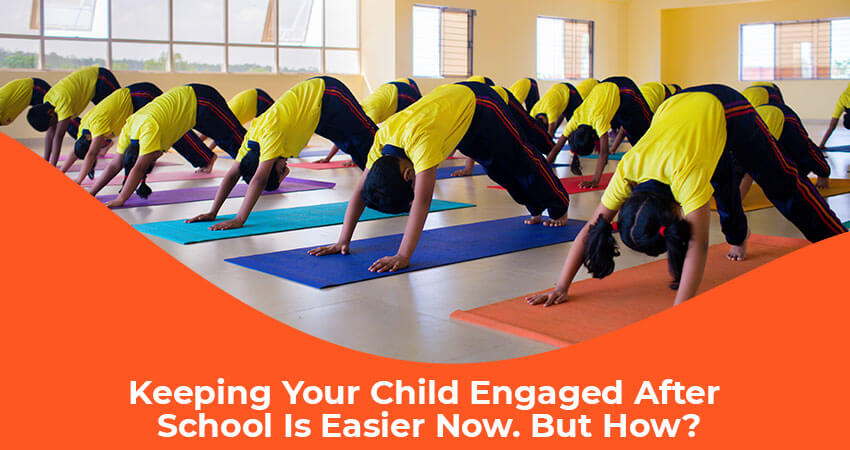
Keeping your child engaged after school is easier now. But How?
“Play is often talked about as if it were a relief from serious learning. But for children play is serious learning. Play is really the work of childhood.”
— Fred Rogers, television personality
The moment we say ‘kids’, we imagine tremendous energy, naughtiness, cuteness, tantrums, headaches and sweet moments with them. Their curiosity always leads them to explore new things.
Kids are always looking for new challenges as they get bored easily of the same activity. This often leaves parents clueless as to how to engage a child.
As a result, parents usually turn to the go-to solution of today’s world – gadgets. These gadgets with their overflowing stream of contents, keep children engaged day-in and out.
But are these gadgets the right way to engage children?
Why are children difficult to handle at times?
When things get hard, we fall apart on the people we feel safest with. Kids do the same thing.
It takes a great deal of emotional and mental work to follow the rules throughout the day, especially for little kids.
Each time a child refrains from hitting that boy who took his toy, holds up her hand and covers her mouth so she doesn’t speak out of turn, or stops himself from running down the hall to recess, they have to restrain themselves. This restraint builds and builds, almost like a bubble.
Then they walk into their safe place, and POP! They can finally let loose and stop having to restrain themselves. They get to let it all go.
But, as a parent, that’s hard to deal with. It’s frustrating when we have a child who hasn’t had a tantrum in months come home from school and cry and whine about every single thing. There are few things we can do to comfort them.
Allow for Downtime
Give kids time, to be kids. Allow them to have time to play and let loose. Get them home and let them relax and play.
What is it that child needs?
Is he an introvert and needs time alone to decompress?
Is the child a mover and needs to run, hop, and play?
Whatever their play needs are, give them time and space.
Avoid reprimanding children, or talking about school work/grades during the time you get to spend.
Here are some activities children enjoy doing on their own and it keeps them occupied.
Painting
Colours are always a fascination for children and almost all of them love to paint. Art is a great medium for children to express their imagination. It’s an important part of brain development. And is an excellent way to engage children. It is always exciting to splash some paint on paper.
Connect with them
Take them out with you, when you need to run errands. Be it paying bills, giving your vehicle for service or going grocery shopping
Assisting in household chores. Involve your child with your daily chores. For example, if you are cooking, ask your child to help out with tiny tasks, like getting 5 tomatoes from the fridge, or washing the vegetables if they are a little older. Assign simple tasks.
Paper craft
Like painting, paper craft activities also allow your child to express and are useful in enhancing creativity. Paper craft activities take a lot of time and require patience. So, it’s a good idea to create something interesting yourself first and present it to your child. This will peek his/her curiosity and thus help him/her get started.
Reading
Everyone loves stories. Children most of all. A well-told story will always engage a child. It also allows a bonding between the parents and child.
Play-Act
Pretend-play with your child will help. Role-playing with your child using their toys is a great way to engage your child. Create an area for pretend play. Get some clay or play-dough. Let them create stories and act them out.
Dance: It takes two to tango!
We all love those dance shows where kids perform amazingly. Even introverted children find dance as a great form of expression. This type of co-curricular activity builds confidence, coordination and kinesthetic intelligence in children and adults. When children learn a new dance form, they are ready to make mistakes and do not have any apprehensions.
Sports: All work and no play makes Jack a dull boy.
Sport help them grow physically, mentally and emotionally with the help of some physically engaging extracurricular activities. They learn to make decisions on behalf of the team and look at the big picture. This is a very tough skill to teach a child, but a sport can help them learn this very easily.
Swimming: Time to dive right in.
Swimming classes help create awareness, especially about personal safety and fighting back in an emergency situation. It is a basic life-skill. It also helps children develop personal growth, which helps with self-development and self-confidence.
Swimming
A great form of exercise and a way of unwinding the child’s energy. It allows children to interact and communicate with peers and parents.
Music: Pitch Perfect
Children find this activity relaxing and helps build their confidence. Musical instruments are much more inexpensive these days. A string instrument can help children improve their concentration.
“So Set the child free….. And let the child sore high.”
RECENT POSTS
- The Discovery of Zero: Origins and Key Contributions
- The Best Qualities of a Teacher
- The Benefits of a Multilingual Education
- Our Facilities
- Importance of Festivals in a Child’s Life
- Building Social Skills at NewAge
- 10 Tips to Help Your Child Crack the First School Interview
- 10 Must-Visit Historical Places in India
- The Power of Reading
- Motivating and Inspiring Teachers